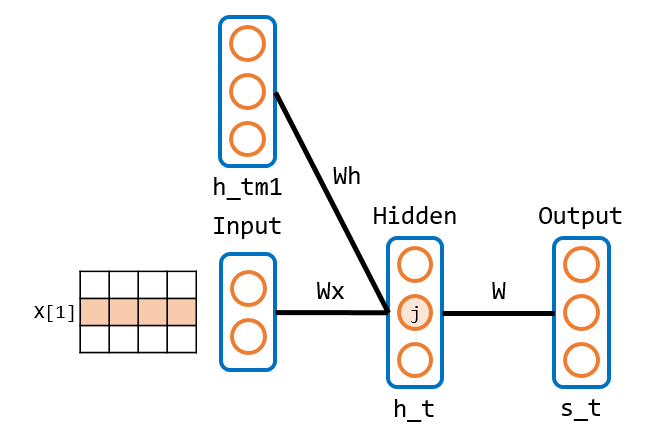TheanoでRNN①
下記のdocumentationについて整理する。
Recurrent Neural Networks with Word Embeddings — DeepLearning 0.1 documentation
タスクについて
assigning a label to each word given a sentence. It’s a classification task.
とある通り、文章の各単語のタグ付け問題である。
Datasetのサンプルを見ると、

IOB表記での固有表現抽出タスクであることが分かる。
全体のソースコードはここにまとめられている。
github.com
笑顔が素敵だ。
elman-forward.py
走らせるのは、elman-forward.py
まずはこのソースを読んでいく。
最初はデータセットの読み込みなので割愛。
まず大事なのはRNNインスタンスの生成部分。
rnn = model(nh = s['nhidden'], # dimension of the hidden layer nc = nclasses, # number of classes ne = vocsize, # number of word embeddings in the vocabulary de = s['emb_dimension'], # dimension of the word embeddings cs = s['win'] ) # word window context size
is13.rnn.elman
parameters of the model
# parameters of the model self.emb = theano.shared(0.2 * numpy.random.uniform(-1.0, 1.0,\ (ne+1, de)).astype(theano.config.floatX)) # add one for PADDING at the end self.Wx = theano.shared(0.2 * numpy.random.uniform(-1.0, 1.0,\ (de * cs, nh)).astype(theano.config.floatX)) self.Wh = theano.shared(0.2 * numpy.random.uniform(-1.0, 1.0,\ (nh, nh)).astype(theano.config.floatX)) self.W = theano.shared(0.2 * numpy.random.uniform(-1.0, 1.0,\ (nh, nc)).astype(theano.config.floatX)) self.bh = theano.shared(numpy.zeros(nh, dtype=theano.config.floatX)) self.b = theano.shared(numpy.zeros(nc, dtype=theano.config.floatX)) self.h0 = theano.shared(numpy.zeros(nh, dtype=theano.config.floatX))
.self.emb:単語の分散表現の重み(分散表現の次元, 語彙数+1)
こんなイメージになる予定。
| word | 1 | 2 | ... |
|---|---|---|---|
| apple | 0.2 | -0.3 | ... |
| orange | -0.4 | 0.1 | ... |
self.Wx:入力層ー隠れ層間の重み(分散表現の次元×文脈サイズ, 隠れ層のユニット数)
self.Wh:一時刻前の隠れ層ー隠れ層の重み(隠れ層, 隠れ層)
Wx, Whは下記に対応

cs224dより引用:
http://cs224d.stanford.edu/lectures/CS224d-Lecture8.pdf
self.W:隠れ層ー出力層の重み(隠れ層, クラス数)
bundle
RNNのメイン部分
# bundle self.params = [ self.emb, self.Wx, self.Wh, self.W, self.bh, self.b, self.h0 ] self.names = ['embeddings', 'Wx', 'Wh', 'W', 'bh', 'b', 'h0'] idxs = T.imatrix() # as many columns as context window size/lines as words in the sentence x = self.emb[idxs].reshape((idxs.shape[0], de*cs)) y = T.iscalar('y') # label def recurrence(x_t, h_tm1): h_t = T.nnet.sigmoid(T.dot(x_t, self.Wx) + T.dot(h_tm1, self.Wh) + self.bh) s_t = T.nnet.softmax(T.dot(h_t, self.W) + self.b) return [h_t, s_t] [h, s], _ = theano.scan(fn=recurrence, \ sequences=x, outputs_info=[self.h0, None], \ n_steps=x.shape[0])
xは(入力データの行数, 分散次元数×ウィンドウサイズ)
次に、recurrence関数。
この呼び出しでscanを利用している。
scanはTheanoでの繰り返し処理を担う。
ここでの引数を見てみると、
sequences:Iteration 処理される引数outputs_info:初期値n_steps:繰り返し処理を行う回数
※入力データxが一行ずつIteration 処理で渡される。
このscanの関数として、recurrence関数を再帰的に呼び出す。
引数などの詳しいことはここで整理した。
kento1109.hatenablog.com
初回のiterationは下記のイメージ

※h_tm1はh0(0)なので、通常のフィードフォワードと同じ流れ
2回目以降のiterationは下記のイメージ

★x_t,h_tm1には、それぞれx(のイテレーション), h_tが与えられる。
これをn_stepsで与えられたx.shape[0](入力データの行数)分繰り返す。
その結果、resultとして今までのh_t, s_tがh, sに渡される。
次に、
p_y_given_x_lastword = s[-1,0,:] p_y_given_x_sentence = s[:,0,:] y_pred = T.argmax(p_y_given_x_sentence, axis=1)
p_y_given_x_lastword:
s[-1,0,:]なので、センテンスの最後の再帰処理のウィンドウの所属クラスの確率ベクトルを取得する。
p_y_given_x_sentence:
s[:,0,:]なので、全てのウィンドウの所属クラスの確率行列を取得する。
最後にあるウィンドウの確率値が最も高いクラスを取得する。
cost and gradients and learning rate
コスト関数と勾配関数の定義
# cost and gradients and learning rate lr = T.scalar('lr') nll = -T.log(p_y_given_x_lastword)[y] gradients = T.grad( nll, self.params ) updates = OrderedDict(( p, p-lr*g ) for p, g in zip( self.params , gradients))
theano functions
関数定義
# theano functions self.classify = theano.function(inputs=[idxs], outputs=y_pred) self.train = theano.function( inputs = [idxs, y, lr], outputs = nll, updates = updates ) self.normalize = theano.function( inputs = [], updates = {self.emb:\ self.emb/T.sqrt((self.emb**2).sum(axis=1)).dimshuffle(0,'x')})
self.classify:識別関数(入力データからラベルを出力)
self.train:訓練関数
self.normalize :正規化関数(embを正規化)
とりあえず、①はここまで